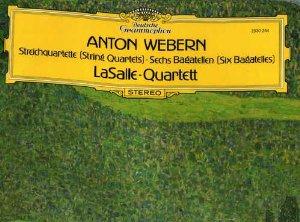Anton Webern – Works for String Quartet (1974)
Anton Webern – Works for String Quartet (1974)

Five Movements For String Quartet, Opus 5 A1 1. Hefrig Bewegt 2:22 A2 2. Sehr Langsam 2:18 A3 3. Sehr Bewegt 0:40 A4 4. Sehr Langsam 1:36 A5 5. In Zarter Bewegung 3:21 String Quartet 1905 A6 String Quartet 12:10 Six Bagatelles For String Quartet, Opus 9 B1 1. Mässig 0:33 B2 2. Leicht Bewegt 0:21 B3 3. Ziemlich Fliessend 0:21 B4 4. Sehr Langsam 0:42 B5 5. Ausserst Langsam 1:10 B6 6. Fliessend 0:24 String Quartet, Opus 28 B7 1. Mässig 3:54 B8 2. Gemächlich 1:45 B9 3. Sehr Fliessend 2:14 La Salle String Quartet: Violin [First] – Walter Levin Violin [Second] – Henry Meyer Viola – Peter Kamnitzer Cello – Jack Kirstein
Anton (von) Webern was one of the key figures in the so-called Second Viennese School. A pupil of Schoenberg, he became known for his concise and highly individual atonal and serial compositions. In many ways he was more influential than his teacher: in the postwar years leading figures in the avant-garde like Boulez, Stockhausen, and Dallapiccola, found more substance in his music and forms than in those of Schoenberg. Hence, one often heard -- and still hears -- the term "post-Webern serialism." His mature style was relatively straightforward, featuring simple harmonies and transparent textures, silent pauses, and brevity of expression. While his influence and stature are acknowledged and his music often played, Webern has landed no work in the standard repertory. Much of his music is viewed as difficult and intellectual by the public, though it is in fact comparatively quite approachable, much less challenging than the works of Boulez, Cage, and others.
Webern's family moved to Graz in 1890, then four years later to Klagenfurt, where he would attend the gymnasium for his general education. He showed talent early on and studied both piano and cello with Edwin Komauer during his early years in Klagenfurt. He graduated from the gymnasium in 1902 and enrolled at the University of Vienna. There he studied under Graedener, Adler, and Navratil. In 1904, however, he began his most serious period of study, when he became a pupil of Schoenberg.
Schoenberg was then, and remained for some time to come, one of the most progressive figures in musical composition, being among the first to write entirely atonal music, and then finalizing his serial technique in the 1920s. Webern now became a close friend of Alban Berg, also one of Schoenberg's pupils. During these years of study, Webern began to focus on vocal composition, turning out several sets of songs. He also wrote some important chamber works, including the String Quartet (1905).
In 1908, Webern launched a career as a conductor, taking a position at Bad Ischl. He was not particularly successful in this new endeavor, but acquired subsequent posts at Teplitz, Danzig, Stettin, and Prague, this last assignment ending in 1918, when he returned to Vienna. During these years Webern had continued to write song collections (for example, Four Songs, Op. 13; 1917), as well as chamber music (Sonata for Cello and Piano; 1914).
After the war, Webern, along with Berg, took part in Schoenberg's Society for Private Musical Performances, an organization dedicated to the performance of modern works. After this, he returned to conducting, but for the most part garnered only secondary posts, such as director of the Vienna Workers' Chorus (1922-1934), which he fulfilled concurrently with other positions. He did manage, however, to obtain regular conducting appearances on Austrian Radio. In 1926, he took on a teaching post at the Jewish Cultural Institute for the Blind.
After the Nazis came to power, Webern's work with the Vienna Workers' Chorus was ended, and four years later, his relationship with Austrian Radio was terminated. He composed three important choral works -- the Cantatas Nos. 1, 2, and 3 -- in the period 1938-1944, and in 1940 he produced his orchestral composition Variations, Op. 30. Webern's death nearly a half year after the end of the war in Europe occurred in a freak incident in Mittersill (near Salzburg) when an American soldier mistakenly shot him while he was on an extended excursion to visit his daughter. --- Robert Cummings, Rovi
download: uploaded yandex 4shared mediafire solidfiles mega zalivalka filecloudio anonfiles oboom
Zmieniony (Piątek, 04 Lipiec 2014 20:55)








